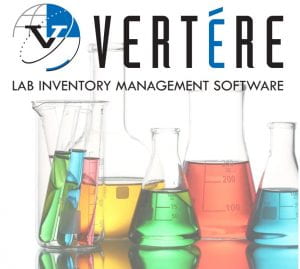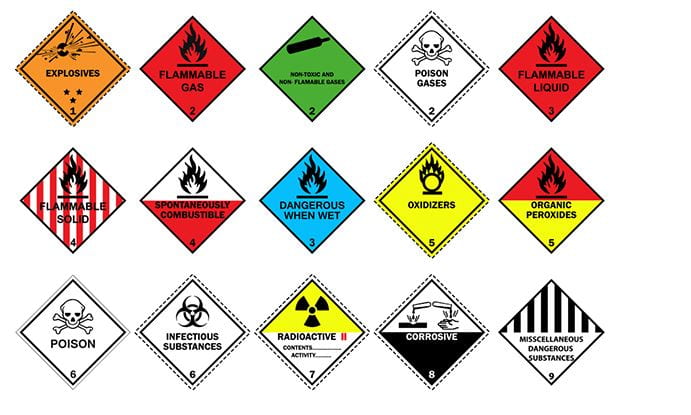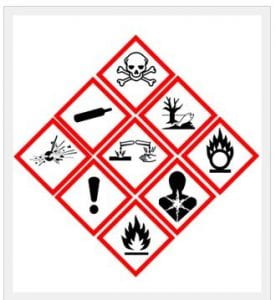Chemical Inventory & Safety Data Sheets (SDS)
The Vertére Inventory Manager is a multi-module inventory management system for managing materials used in research. Here, in the Physical Science Complex, Vertere is the system of choice for the management of hazardous chemicals. Researchers are required to barcode all materials falling under any of the following DOT hazard classes and/ or recognized under the Globally Harmonized System as hazardous materials.
Hazard Class Definitions
- Flammable liquid is defined as a liquid whose flash point does not exceed 100°F, when tested by closed‐cup test methods, while a combustible liquid is one whose flash point is 100°F or higher, also when tested by closed‐cup methods. These broad groups are further classified as follows:
- Class IA ‐ Flash Point less than 73°F; Boiling Point less than 100°F
- Class IB ‐ Flash Point less than 73°F; Boiling Point equal to or greater than 100°F
- Class IC ‐ Flash Point equal to or greater than 73°F, but less than 100°F
- Class II ‐ Flash Point equal to or greater than 100°F, but less than 140°F
- Class IIIA ‐ Flash Point equal to or greater than 140°F, but less than 200°F
- Class IIIB ‐ Flash Point equal to or greater than 200°
- Cryogenic Liquid is a fluid having a boiling point lower than -130°F (-89.9°C) at 14.7 pounds per square inch absolute (psia) (an absolute pressure of 101.3 kPa).
- Flammable Cryogenic liquid. A cryogenic fluid that is flammable in its vapor state.
- Organic peroxide – An organic compound that contains the bivalent -O-O- structure and which may be considered to be a structural derivative of hydrogen peroxide where one or both of the hydrogen atoms have been replaced by an organic radical. Organic peroxides can present an explosion hazard (detonation or deflagration), can be shock sensitive, can be susceptible to decomposition into various unstable compounds over an extended period of time and are classified as follows based upon their hazardous properties:
- Class I-Organic peroxides that are capable of deflagration but not detonation.
- Class II -Organic peroxides that burn very rapidly and that pose a moderate reactivity hazard.
- Class III – Organic peroxides that burn rapidly and that pose a moderate reactivity hazard.
- Class IV– Organic peroxides that burn in the same manner as ordinary combustibles and that pose a minimal reactivity hazard.
- Class V –Organic peroxides that burn with less intensity than ordinary combustibles or do not sustain combustion and that pose no reactivity hazard.
- Unclassified detonable –Organic peroxides that are capable of detonation and pose an extremely high-explosion hazard through rapid explosive decomposition.
- Oxidizer- A material that readily yields oxygen or other oxidizing gas, or that readily reacts to promote or initiate combustion of combustible materials and, if heated or contaminated, can result in vigorous self-sustained decomposition, classified as follows:
- Class 1– An oxidizer that causes a readily measurable increase in the burning rate of combustible materials with which it comes in contact, but less than a moderate increase.
- Class 2 – An oxidizer that causes a moderate increase in the burning rate of combustible materials with which it comes in contact.
- Class 3 – An oxidizer that causes a severe increase in the burning rate of combustible materials with which it comes in contact.
- Class 4 – An oxidizer that can undergo an explosive reaction due to contamination or exposure to thermal or physical shock and causes a severe increase in the burning rate of combustible materials with which it comes in contact.
- Unstable (reactive) Material- A material, other than an explosive, which in the pure state or as commercially produced, will vigorously polymerize, decompose, condense or become self-reactive and undergo other violent chemical changes, including explosion, when exposed to heat, friction or shock, or in the absence of an inhibitor, or in the presence of contaminants, or in contact with incompatible materials. Unstable (reactive) materials are classified as follows:
- Class 1– Materials that in themselves are normally stable but which can become unstable at elevated temperatures and pressures.
- Class 2 – Materials that in themselves are normally unstable and readily undergo violent chemical change but do not detonate. This class includes materials that can undergo chemical change with rapid release of energy at normal temperatures and pressures, and that can undergo violent chemical change at elevated temperatures and pressures.
- Class 3 – Materials that in themselves are capable of detonation or of explosive decomposition or explosive reaction but which require a strong initiating source or which must be heated under confinement before initiation. This class includes materials that are sensitive to thermal or mechanical shock at elevated temperatures and pressures.
- Class 4–Materials that in themselves are readily capable of detonation or explosive decomposition or explosive reaction at normal temperatures and pressures. This class includes materials that are sensitive to mechanical or localized thermal shock at normal temperatures and pressures.
- Water Reactive– A material that explodes, violently react, produces, flammable, toxic or other hazardous gases and/ or generates enough heat to cause autoignition or ignition of combustible materials upon exposure to water or moisture. Water reactive materials are classified as follows:
- Class 1 -Materials that react with water with some release of energy, but not violently.
- Class 2-Materials that react violently with water or cause water to boil upon contact: produce flammable, toxic or other hazardous gases upon contact with water; or upon contact with water generate sufficient heat to cause autoignition or ignition of adjoining combustible materials.
- Class 3 -Materials that react explosively with water without requiring heat or confinement.
- Corrosive– a chemical that causes visible destruction of , or irreversible altercations in living tissues by chemical action at the site of contact.
- Compressed Gas – material, or mixture of materials that:
- Is a gas at 68°F (20°C) or less at 14.7 psia (101 kPa) of pressure; and
- Has a boiling point of 68°F (20°C) or less at 14.7 psia (101 kPa) which is either liquefied, nonliquefied or in solution, except those gases which have no other health-or physical-hazard properties are not considered to be compressed until the pressure in the packaging exceeds 41 psia (282 kPa) at 68°F (20°C).
- Nonliquefied compressed gases are gases, other than those in solution, which are in a packaging under the charged pressure and are entirely gaseous at a temperature of 68°F (20°C).
- Liquefied compressed gases are gases that, in a packaging under the charged pressure, are partially liquid at a temperature of 68°F (20°C).
- Toxic– a material that produces a lethal dose or lethal concentration within any of the following categories:
- Ingestion: chemical that has a median lethal dose (LD50) of more than 50 milligrams per kilogram, but not more than 500 milligrams per kilogram of body weight when administered orally to albino rats weighing between 200 and 300 grams each.
- Absorption-Skin: A chemical that has a median lethal dose (LD50) of more than 200 milligrams per kilogram but not more than 1,000 milligrams per kilogram of body weight when administered by continuous contact for 24 hours (or less if death occurs within 24 hours) with the bare skin of albino rabbits weighing between 2 and 3 kilograms each.
- Inhalation: A chemical that has a median lethal concentration (LC50) in air of more than 200 parts per million but not more than 2,000 parts per million by volume of gas or vapor, or more than 2 milligrams per liter but not more than 20 milligrams per liter of mist, fume or dust, when administered by continuous inhalation for 1 hour (or less if death occurs within 1 hour) to albino rats weighing between 200 and 300 grams each.
- Highly toxic– A material which produces a lethal dose or lethal concentration which falls within any of the following categories:
- Ingestion: A chemical that has a median lethal dose (LD50) of 50 milligrams or less per kilogram of body weight when administered orally to albino rats weighing between 200 and 300 grams each.
- Absorption (skin): A chemical that has a median lethal dose (LD50) of 200 milligrams or less per kilogram of body weight when administered by continuous contact for 24 hours (or less if death occurs within 24 hours) with the bare skin of albino rabbits weighing between 2 and 3 kilograms each.
- Inhalation: A chemical that has a median lethal concentration (LC50) in air of 200 parts per million by volume or less of gas or vapor, or 2 milligrams per liter or less of mist, fume or dust, when administered by continuous inhalation for one hour (or less if death occurs within 1 hour) to albino rats weighing between 200 and 300 grams each.
 The Vertere system can be accessed here.
The Vertere system can be accessed here.
Chemicals obtained through the chemistry department stockroom are provided with barcodes however, users must use the handheld scanner at the user station to transfer materials from stockroom inventory to individual user inventories.
Barcodes must be removed from empty containers and returned to the Vertere system administrator to update the user inventory.
Re-inventory occurs annually or bi-annually for Complex users.
Safety data sheets are available online through Chemwatch. These can be accessed directly through the Vertere inventory interface by clicking on the CW symbol or using the following link:
https://sp.ehs.cornell.edu/lab-research-safety/research-safety/msds/Pages/default.aspx
The Vertere system administrator is Yvonne Ellis. She can be reached at yme2@cornell.edu or 255-4123.


